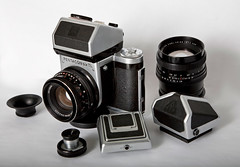Camera system
A camera system is a set of well-matched camera components which can be assembled quickly for usage as camera, including the option of fast exchange of at least one of the components by another component variant.
A system camera is a camera body with one or more mounts for such interchangeable components. The camera body itself can be seen as interchangeable component of the related camera system.
Contents
Lens bayonet

|
| Pentacon Six image by Ubiquitouscam (Image rights) |
The most common type of system camera has a bayonet mount for attachment of a system lens. Modern bayonet mounts include facilities to set certain lens settings automatically and to transfer actual lens setting values to the camera. The first kinds of such system-specific lens couplings were mechanical ones:
- SLR cameras with ...
- ... aperture release ...
- Releasing the shutter causes the camera to trigger the lens's diaphragm to reduce aperture size from maximum to the selected value before opening the shutter. This enables the camera user to set the correct aperture for exposure before focusing so that focusing the image subject can be done while having the reflex finder as bright as possible.
- ... and aperture setting transfer
- The aperture selection is transfered to the camera, so that the camera body's internal light meter can generate at least a suggestion for (or even an automatic setting of) an appropriate shutter speed.
- ... aperture release ...
- Rangefinder cameras with ...
- ... distance setting transfer
- The system lens's distance ring is coupled to the camera body's rangefinder.
- ... distance setting transfer
Some lens bayonets had also a mechanical transfer of aperture setting values to the lens, enabling automatic exposure with shutter speed priority. Nowadays most lens bayonets include electric contacts to transfer digital control signals from and to the lens. Some older bayonets for autofocus camera systems include a coupling rear element to connect the lens's focusing mechanics to a motor in the camera. Newer systems use just self-motorized system lenses.
Simpler lens mounts
The early camera system lens bayonets were just facilities for making lens exchange faster than possible with screw mounts. But some early cameras systems were even based on screw mounts, for examples SLR systems based on M42 thread mount and Rangefinder camera systems based on M39 screw mount. Both screw mounts were popular and used by several different camera makers. Between 1945 and 1985 there was almost no renowned lens maker who neither made any M42 lens nor any M39 lens. The M42 mount was soon enhanced by an aperture release pin in the lenses' screw mounts. This could facilitate focusing with wide aperture if the aperture release could be triggered by a corresponding lever in the camera's lens mount. A few M42 system cameras like the Praktica PLC 2/PLC 3 could use special M42 lenses with electrical contacts for aperture setting value transfer to the camera, like its possible with common bayonet mounts.

|
| Topcon, early 35mm SLR system with Exakta lens bayonet and interchangeable reflex finder heads image by rst12 (Image rights) |
Lens board
Large format camera systems usually have a certain mount for system lens boards.

|
| Lens boards for Speed Graphic cameras, equipped with different historic lens/shutter combinations image by John Bosko (Image rights) |
Focusing facility
Some camera systems have interchangeable focusing facilities. Large format cameras may have interchangeable focusing screens. Some medium format and 35mm SLR systems have interchangeable viewfinder modules which contain the matte screen and the screen viewing optics of the cameras' reflex finders.
Other components
The accessory shoe of many modern system cameras is often usable as hot shoe for a simple flashgun or as connector for other standard accessories. But its additional system-specific electrical contacts make it also part of the camera system, allowing to use special optimized flashguns of the camera system, or, in case of digital system cameras, an electronic viewfinder module. Some camera systems use a system-specific flash mount instead of an enhanced standard hot shoe.
Modern professional medium format system cameras have a mount which must be used to attach either a rollfilm holder or a digital back.
Large format camera systems may allow exchange of bellows and camera back to be applicable for different formats.
Camera modules
Some camera systems have complete camera modules as interchangeable system components. The body of such a system camera is just a housing for basic support functions like battery chamber, memory device, accessory and cable mounts, display, and maybe an electronic viewfinder. The attachable autofocus camera modules contain the image sensor and the camera lens. Samples for such camera systems are the Minolta Dimâge EX and the Ricoh GXR.